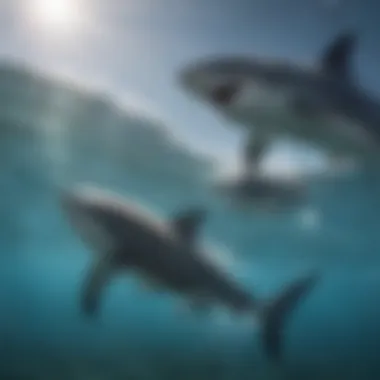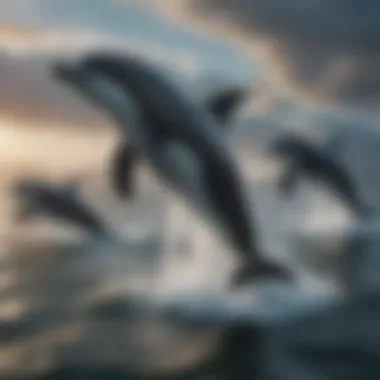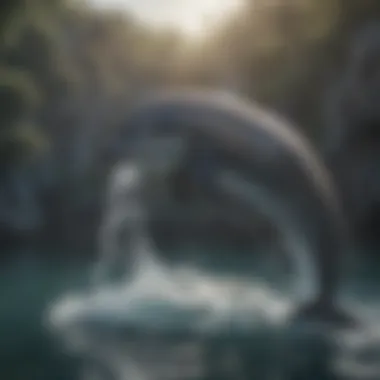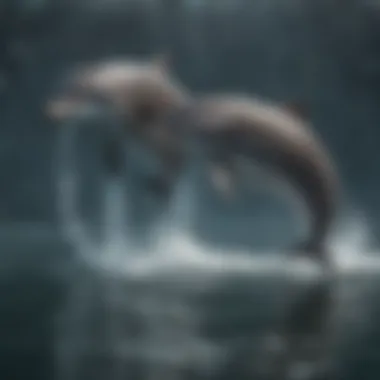Dolphins and Their Natural Adversaries: A Complex Relationship


Intro
Dolphins are often viewed as graceful and intelligent creatures, admired for their playful demeanor. However, their lives are not without peril. The environment and other species pose a variety of threats. Understanding the complexity of the interactions between dolphins and their adversaries is critical. This article aims to dissect these relationships, highlighting the challenges dolphins face in their natural habitat. The information presented will offer insights into their ecological roles and the significance of these relationships in wildlife conservation efforts.
Natural Enemies of Dolphins
Dolphins encounter various natural enemies, which can range from direct predators to environmental challenges. Understanding these adversities provides a clearer picture of their behavior and survival strategies.
Predatory Threats
Sharks are the most recognized natural predators of dolphins, particularly species like the Great White and Tiger sharks. These predators often hunt individual dolphins, especially the young or injured.
"Dolphins have developed several defensive strategies to evade sharks, including swimming in tight formations."
Another notable threat comes from Orkas, or killer whales, which view dolphins as prey. The predation strategies of orcas differ, often involving teamwork in groups to catch dolphins.
Competition for Resources
Apart from predation, dolphins also face competition from other marine animals. For instance, larger fish species compete for the same food sources. This competition can pressure dolphin populations to adapt their foraging behaviors. Besides active predators, competition can also stem from humans through overfishing and habitat degradation, which can significantly lessen available resources for dolphins.
Environmental Challenges
Dolphins are sensitive to changes in their environments. Pollutants, noise pollution, and climate change are significant threats. Toxic substances from industrial waste can accumulate in marine ecosystems, leading to health issues in dolphin populations.
Climate Change Impact
The rise of ocean temperatures affects marine life, disrupting food chains. Dolphins may find it difficult to locate prey, thus altering their feeding patterns and migration routes. Such changes can also influence mating behaviors, further endangering their populations.
Behavioral Adaptations
To survive in the presence of these threats, dolphins exhibit remarkable behavioral adaptations. Their intelligence plays a pivotal role in these strategies. Some dolphins engage in social learning, where knowledge about threats and foraging is shared within pods. By working collectively, dolphins increase their chances of surviving predation and resource competition.
Conservation Challenges
The intricate dynamics between dolphins and their natural adversaries underscore critical conservation challenges. Understanding these relationships enhances the effectiveness of protective measures. Conservation strategies must focus not only on protecting dolphins from direct threats but also addressing broader environmental issues that contribute to their decline.
The Importance of Research
Ongoing research is essential to monitor dolphin populations and their habitats. Collaborative efforts among scientists, conservationists, and policymakers can create effective initiatives for dolphin conservation.
In summary, the interactions between dolphins and their adversaries encompass a network of biological and environmental factors. By recognizing the complexity of these relationships, we can better appreciate the delicate balance of marine ecosystems and work towards effective conservation strategies.
Understanding Dolphin Species
The exploration of dolphin species is critical for comprehending the dynamics between these marine mammals and their natural adversaries. Dolphins, being social creatures, possess diverse traits, sizes, and behaviors that contribute to their survival in various environments. By studying these species, we can identify the ecological roles they play and how adaptations affect their interactions with predators and competitors. Furthermore, recognizing specific species helps in targeting conservation efforts effectively and appreciating the complex ecosystems they inhabit.
Diversity Among Dolphins
Dolphin diversity ranges from the common bottlenose dolphin to the lesser-known species like the orca. There are over 40 recognized species of dolphins, each exhibiting distinct characteristics. For instance,


- Bottlenose dolphins are known for their intelligence and adaptability, thriving in both wild and controlled environments.
- Orcas, although often referred to as dolphins, belong to a distinct family and are the largest members of the dolphin family. Their strategies for hunting and social structures differ significantly from those of smaller dolphin species.
Understanding these variations is essential. Each species interacts uniquely with its environment and faces specific threats from both predators and human activities. For example, smaller dolphin species may be more vulnerable to shark attacks given their size, while larger species like the orca may dominate certain ecosystems through their apex predator status.
Habitat and Distribution
Dolphins inhabit a wide range of marine environments, from coastal regions to the deep ocean. Their distribution is influenced by several factors:
- Water temperature: Many dolphin species prefer warmer waters, which are abundant in nutrients and marine life.
- Food availability: Areas with high concentrations of fish and squid attract dolphins for feeding purposes.
- Breeding grounds: Dolphins tend to migrate to specific regions to breed, ensuring the survival of their young.
Dolphins are found in every ocean, often demonstrating preference for shallow waters where prey is plentiful.
Understanding dolphin habitats aids researchers in assessing potential risks they face from changing climates and human encroachment. This knowledge is pivotal in developing action plans for the effective management of dolphin populations.
Natural Predators of Dolphins
The presence of natural predators plays a crucial role in shaping dolphin behavior and ecology. Understanding these interactions sheds light not only on the effectiveness of dolphins' survival strategies but also on the balance of marine ecosystems. As apex predators themselves, dolphins face various threats from other predator species. Examining these complex relationships enables us to appreciate the intricate web of life in ocean habitats.
Sharks: Apex Predators
Sharks represent one of the most significant threats to dolphins in the wild. Many shark species, including great whites and tiger sharks, are known to hunt dolphins. These encounters often occur in coastal areas where both species converge. Dolphins may use speed and agility to evade sharks, which are known for their powerful bite and keen sense of smell. However, it is essential to note that not all shark interactions are lethal. Research indicates that dolphins have learned to anticipate and avoid many types of shark attacks.
Sharks, in their role as apex predators, help regulate dolphin populations. This predatory relationship maintains ecological balance. Without sharks, dolphin populations could increase uncontrollably, leading to overgrazing on fish populations, disrupting the marine food chain.
Orcas: The Largest Dolphin
Orcas pose a unique challenge for dolphins. As the largest member of the dolphin family, orcas exhibit sophisticated hunting techniques that can include cooperative strategies, making them formidable foes. Orcas have been observed hunting dolphins in pods, using teamwork and intelligence to outsmart their prey. Such strategies amplify the significance of orcas within their ecological niche.
What is surprising is the variety of hunting methods employed by orcas, tailored to different species of dolphins. Depending on the local dolphin population, orcas might implement tactics ranging from ambush to prolonged pursuits. This predatory behavior influences not only dolphin social structures but also their migration patterns, as they may alter their routes to avoid orca hotspots.
Other Marine Mammals
Dolphins may also encounter threats from other marine mammals, such as larger whale species. Some baleen whales, particularly during feeding, can inadvertently harm dolphins if they get too close. Notably, sperm whales have been documented to inflict injuries or even cause fatalities when they engage in competitive feeding practices.
Additionally, while interactions between species are varied, intraspecies competition among dolphins can occur as well. For instance, aggressive encounters during resource access may lead to injuries that can attract larger predators. Understanding these dynamics highlights the challenges dolphins face from not only their direct predators but also from their own species.
Understanding the role of natural predators is necessary to appreciate dolphin behavior and their ecological importance. Predation pressure shapes their evolution, social structures, and habitats.
Human Influences on Dolphin Populations
Human activities have a profound impact on the ecosystems where dolphins reside. The implications of our actions extend beyond immediate effects, leading to long-term challenges for dolphin populations. Understanding these influences is crucial for developing effective conservation strategies and ensuring the sustainability of dolphin species.
Commercial Fishing Practices
Commercial fishing practices pose significant threats to dolphin populations. Bycatch is a major concern, where dolphins unintentionally get caught in nets or fishing gear. This not only reduces their numbers but can also lead to injury or death.
In addition, certain fishing methods, such as gillnetting, are particularly harmful. These nets can entrap dolphins, making it hard for them to reach the surface for air. Reports indicate that thousands of dolphins die annually due to bycatch across various fisheries.
The overfishing of prey species like fish and squid also affects dolphin survival. When these populations dwindle, dolphins face shortages of food, which can lead to starvation and reduced reproductive success.


Pollution and Habitat Destruction
Pollution is another critical aspect influencing dolphin populations. Oceans are increasingly becoming dumping grounds for plastic, chemicals, and other harmful substances. Plastics can be especially dangerous, as dolphins may ingest them or become entangled, causing serious injury or death.
Moreover, chemical pollutants can enter the food chain, affecting the health of dolphins. Contaminants such as heavy metals and polychlorinated biphenyls (PCBs) accumulate in dolphin bodies, leading to reproductive and immune system problems.
Habitat destruction, such as coastal development and deforestation, further limits the space dolphins have for breeding and feeding. Degradation of essential habitats like estuaries can have devastating effects on dolphin populations, making it harder for them to thrive.
Marine Traffic and Collisions
With increasing marine traffic, collisions between dolphins and boats have become a frequent occurrence. These incidents can result in serious injuries or fatalities for dolphins. The rise in recreational boating, shipping, and fishing activities in coastal waters increases risks for these animals.
High noise levels from marine traffic can disrupt dolphin communication and echolocation, making it harder for them to find food and navigate their environment.
Efforts to mitigate these impacts include implementing speed limits and designated passageways for boats in sensitive dolphin habitats. However, compliance with these measures remains challenging, highlighting the need for better awareness and regulation.
Effective management of human activities in marine environments is essential for the survival of dolphin populations.
Intraspecies Competition
Intraspecies competition is a critical aspect of understanding dolphins' social structure and survival strategies. This competition occurs among individuals of the same species and can influence many behavioral and ecological factors. Given the complexities of dolphin societies, exploring this topic sheds light on how dolphins interact with each other, what drives their social dynamics, and how these interactions affect their chances of survival in a challenging environment.
Territory and Resources
Territoriality is a key element in the lives of many dolphin species. Dolphins often establish areas they defend against intruders. These territories are not just physical spaces but are also rich in resources, such as food and social opportunities. The competition for territory can become intense, especially in regions where food is scarce.
Dolphins engage in both active and passive territorial defense. Active defense may include displaying aggression against intruders, while passive strategies involve using social calls and sonar to deter competitors. The outcome of these territorial disputes can have significant consequences for the victors and the vanquished.
Successful territory holders can access better feeding grounds, which in turn enhances their overall fitness. Likewise, young dolphins learning the nuances of territoriality will need to navigate these social landscapes carefully to secure their place in the pod. Knowledge of these dynamics can help in conservation strategies, ensuring that critical habitats are protected from human encroachment and degradation.
"Understanding the significance of territory in dolphin populations is essential for effective wildlife management strategies."
Mating and Social Dynamics
Mating competition is another vital component of intraspecies interactions in dolphins. Courtship behavior can vary widely among species, but displays of strength, agility, and social bonds tend to be common. For example, males may engage in intricate acrobatic displays to attract females. Males frequently compete for the attention of females, leading to a hierarchy within pods.
Social dynamics in mating scenarios can create alliances, where certain males may cooperate to increase their chances of mating success, yet other times may lead to aggressive confrontations. The outcomes of these interactions can shape the genetic diversity within dolphin populations.
Dolphins also display complex social structures, which can reflect their mating strategies. For instance, the presence of stable female pods can encourage cooperation among males, while solitary males may choose more aggressive tactics to establish dominance. Understanding these dynamics offers insight into the behaviors that promote reproduction and survival in challenging marine environments.
In summary, examining intraspecies competition provides critical insights into the social structures of dolphins. From territorial disputes to mating strategies, these interactions dictate not only individual success but also the overall health and sustainability of dolphin populations.
Behavioral Adaptations
Dolphins, as intelligent and dynamic marine mammals, have evolved several behavioral adaptations to enhance their survival against natural adversaries. These behaviors are crucial, as they enable dolphins to respond effectively to a variety of threats, including predation and environmental changes. Understanding these adaptations offers insight into dolphin resilience, social structures, and their responses to human-induced challenges.
Evasive Maneuvers
One of the primary behavioral adaptations observed in dolphins is their capacity for evasive maneuvers. Such tactics are essential for survival, particularly when they encounter predators like sharks or orcas. Dolphins are known for their agility in the water, allowing them to execute rapid directional changes, leaps, and dives that confuse or escape from potential threats. This ability to swiftly change speed or direction enables them to evade pursuers effectively.


Evasive maneuvers serve multiple purposes beyond immediate survival. By employing these tactics, dolphins also protect their calves and maintain group cohesion during sudden encounters with predators. Observations have shown that when faced with danger, dolphins often exhibit frantic swimming patterns and coordinated movements with other group members.
Moreover, these maneuvers are not random but rather strategic. Dolphins might assess the behavior of a predator before deciding on a response. They can quickly determine if a threat is imminent and alter their swim patterns accordingly. This level of awareness highlights their cognitive abilities and the importance of social learning within pods, where experiences with predators can be shared and adapted over time.
Group Behavior for Protection
Group behavior plays a vital role in the survival of dolphins, particularly in the context of protection against predators. Dolphins often travel in pods, where their collective strength serves as a safeguard against potential threats. This cooperative strategy enhances the chances of survival for individual members, especially the young and vulnerable.
When a predator is detected, dolphins will often form a tight circle, positioning themselves protectively around weaker members of the group. This formation makes it more difficult for a predator to attack and provides a united front against any encroaching threats. Additionally, dolphins may engage in coordinated swimming patterns to further confound predators.
The social structures of dolphin pods facilitate this protective group behavior. Each member of the group plays a role based on their age and experience, which invariably contributes to the overall effectiveness of the pod in warding off predators. Some studies suggest that dolphins possess a sophisticated communication system that allows them to relay information about potential dangers or attacks, further strengthening their collective defense.
"Cooperative behavior among dolphins not only enhances their survival but also fosters social bonds within the pod."
Understanding these behavioral adaptations reveals much about the complex life of dolphins and their interactions with both natural and anthropogenic threats. As we witness changes in their habitats and interactions due to human activity, recognizing these adaptations becomes crucial for their conservation and management.
Conservation Status
The conservation status of dolphins is of utmost importance in understanding their survival against various adversities. This section provides an encompassing view of the challenges dolphins face in their natural habitats. Recognizing their conservation needs is essential for effective wildlife management and conservation efforts.
Threatened and Endangered Species
Dolphins encompass a range of species and some of them are classified as threatened or endangered. For instance, the Vaquita, a small porpoise species found in the Gulf of California, is critically endangered due to bycatch in illegal fishing nets. Another example is the Atlantic humpback dolphin, which is facing habitat loss and boat traffic. The IUCN Red List provides ongoing assessments of these species, offering insights into their population trends and threats.
- Common threats to these species include:
- Habitat degradation
- Accidental capture in fishing gear
- Pollution which impacts their health and food sources
Efforts to protect these species are crucial. Without targeted action, these dolphins risk extinction, leading to irreversible loss of biodiversity.
Global Conservation Efforts
Global initiatives are underway to protect dolphin populations worldwide. Organizations and marine conservation groups work tirelessly to create and enforce regulations to prevent exploitation of dolphin species. Some notable efforts include:
- International Whaling Commission: This body plays a pivotal role in regulating whaling to ensure marine life sustainability.
- Marine Protected Areas (MPAs): These zones prohibit destructive activities such as fishing, allowing ecosystems to recover.
- Public Awareness Campaigns: Educating the public about the importance of dolphins and how to protect them is vital.
"Conservation is a constant process, not a one-time event."
Additionally, research initiatives on dolphin biology and ecology contribute to a better understanding of their needs. Collaborative efforts across borders help to strengthen laws against poaching and habitat destruction.
Future Research Directions
Dolphins inhabit complex ecosystems and their interactions with natural adversaries necessitate further investigation. Research in this area can yield vital insights into behavioral responses, social structures, and the role of environmental factors affecting dolphin populations. Identifying how dolphins adapt to threats not only enriches our understanding but also aids conservation efforts.
Understanding Social Structures
Social structures in dolphin populations largely influence their behavior and interactions with predators. Dolphins often travel in groups, known as pods, which can significantly enhance their survival. Research could focus on how these social dynamics influence foraging strategies and protection against natural adversaries. For example, coordination within a pod can help in evading a shark attack.
The ways dolphins communicate within their pods is another area for study. Understanding the tonal variations and body language could shed light on how they work together during encounters with threats. Analyzing these elements provides deeper insights into their social intelligence and adaptability. To study these complex social interactions, researchers might employ tagging technology, enabling them to track pod movements and behaviors more accurately.
Impact of Climate Change
Climate change poses a significant and looming threat to dolphin habitats. Rising ocean temperatures, increasing acidification, and habitat destruction all affect dolphin populations. This section examines how climate change influences dolphin distribution and interactions with their natural adversaries.
For instance, as sea temperatures rise, some predator species may migrate to new areas, impacting dolphin population dynamics. Furthermore, changes in marine ecosystems can alter food availability for both dolphins and their predators.
Research must prioritize understanding these ecological shifts and their subsequent effects. It is crucial to assess how changes in water temperature and pollution affect dolphin prey and their competition with other species. This knowledge will contribute to better management strategies targeting both dolphin conservation and maintaining ecological balance.
"Understanding the intricate web of life in marine ecosystems is indispensable for effective conservation efforts."
As we delve deeper into these research directions, prioritizing interdisciplinary approaches and pooling diverse expertise will be essential. By focusing on the aforementioned elements, researchers can contribute to the broader goal of safeguarding dolphin populations and their habitats.







